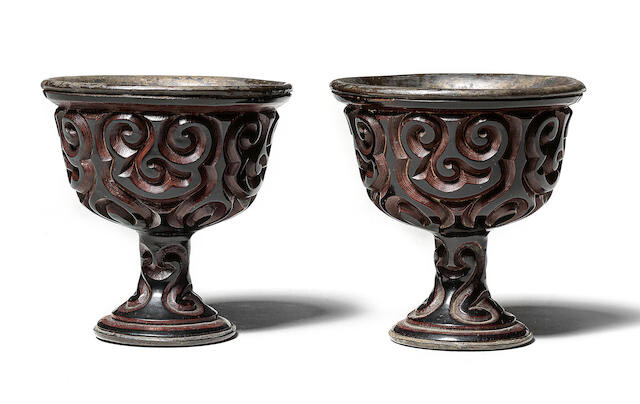A PAIR OF CARVED TIXI LACQUER STEM CUPS
16th century
16th century
Each deeply carved around the exterior through layers of brown and red lacquer with guri scrolls, all supported on a high spreading foot, the interior of the bowls with silver lining. 8.5cm (3 3/8in) high. (2).
十六世紀 剔犀高足盃一對
Provenance:
Captain W.F. Collins (1865-1948), Beijing, who sent the stem cups to Bluett's on 1 October 1926
Bluett & Sons Ltd., London
E. A. Parry (1879-1946), London, acquired from the above on 7 June 1927, and thence by descent
Captain William Fellows Collins, was agent in Peking of the Anglo-French China Corporation Ltd and of S. Pearson & Son, and supplied Bluett's, John Sparks, Franck & Co and other dealers with consignment of Chinese ceramics and works of art from Beijing. He later reached the rank of Colonel and was awarded the DSO. For more information about Collins, see R.Davids and D.Jellinek, Provenance, Oxon, 2011, p.124.
來源:
高林士(1865-1948)於1926年10月1日由北京送至倫敦古董商Bluett's
倫敦古董商Bluett & Sons Ltd.
倫敦E. A. Parry(1879-1946)舊藏,於1927年6月7日購自上者,並由後人保存迄今
高林士(William F. Collins上尉),時任聯華銀公司(Anglo-French China Corporation Ltd)及英國培生集團(S. Pearson & Son)駐北京代理,並為英國Bluett's、John Sparks、Franck & Co 等古董商由北京提供中國古董及藝術品。其後擢升至上校,並被授予傑出服務勳章。有關高林士的具體信息,參見R.Davids與D.Jellinek著,《Provenance》,牛津,2011年,頁124。
The tixi technique, which originated during the Southern Song dynasty and remained popular well into the Ming dynasty, refers to the application of multiple layers of two or more contrasting colours of lacquer that are then carved at an angle. The time-consuming process of waiting for each layer to dry before carving resulted in a texture that resembled rhinoceros horn, hence the name tixi, ti (to carve) and xi (rhinoceros).
Compare with a similar pair of tixi lacquer stem cups, 16th century, in the British Museum (acc.no.1974,0226.7). Another similar lacquer stem cup is in the collection of the Ashmolean Museum, Oxford (acc.no.EA1965.4).
A similar carved brown tixi lacquer stem cup, 16th/17th century, was sold at Sotheby's London, 18 May 2018, lot 318.
內壁包銀,高足外撇,外壁棕紅二色漆層厚重,以流暢而婉轉之刀法深刻如意雲紋。剔犀一法源自南宋,至明代依然流行。該法首先在器胎上逐層髹塗兩種或更多色漆,漆層可至數百道之多,後以斜鋒下刀,呈現流暢婉轉之紋路。與剔紅不同,剔犀一法需等漆層變硬後才下刀,因此製作十分費時,但效果即如犀角般流光溢彩,因有其名。
倫敦大英博物館藏一對十六世紀剔犀高足盃,藏品編號1974,0226.7,可資比對。亦可參看牛津阿什莫林博物館所藏一件剔犀高足盃,藏品編號EA1965.4。倫敦蘇富比亦曾於2018年5月18日售出一件與本品相類之十六/十七世紀剔犀高足盃,拍品編號318。
View it on
Sale price
Estimate
Time, Location
Auction House
16th century
16th century
Each deeply carved around the exterior through layers of brown and red lacquer with guri scrolls, all supported on a high spreading foot, the interior of the bowls with silver lining. 8.5cm (3 3/8in) high. (2).
十六世紀 剔犀高足盃一對
Provenance:
Captain W.F. Collins (1865-1948), Beijing, who sent the stem cups to Bluett's on 1 October 1926
Bluett & Sons Ltd., London
E. A. Parry (1879-1946), London, acquired from the above on 7 June 1927, and thence by descent
Captain William Fellows Collins, was agent in Peking of the Anglo-French China Corporation Ltd and of S. Pearson & Son, and supplied Bluett's, John Sparks, Franck & Co and other dealers with consignment of Chinese ceramics and works of art from Beijing. He later reached the rank of Colonel and was awarded the DSO. For more information about Collins, see R.Davids and D.Jellinek, Provenance, Oxon, 2011, p.124.
來源:
高林士(1865-1948)於1926年10月1日由北京送至倫敦古董商Bluett's
倫敦古董商Bluett & Sons Ltd.
倫敦E. A. Parry(1879-1946)舊藏,於1927年6月7日購自上者,並由後人保存迄今
高林士(William F. Collins上尉),時任聯華銀公司(Anglo-French China Corporation Ltd)及英國培生集團(S. Pearson & Son)駐北京代理,並為英國Bluett's、John Sparks、Franck & Co 等古董商由北京提供中國古董及藝術品。其後擢升至上校,並被授予傑出服務勳章。有關高林士的具體信息,參見R.Davids與D.Jellinek著,《Provenance》,牛津,2011年,頁124。
The tixi technique, which originated during the Southern Song dynasty and remained popular well into the Ming dynasty, refers to the application of multiple layers of two or more contrasting colours of lacquer that are then carved at an angle. The time-consuming process of waiting for each layer to dry before carving resulted in a texture that resembled rhinoceros horn, hence the name tixi, ti (to carve) and xi (rhinoceros).
Compare with a similar pair of tixi lacquer stem cups, 16th century, in the British Museum (acc.no.1974,0226.7). Another similar lacquer stem cup is in the collection of the Ashmolean Museum, Oxford (acc.no.EA1965.4).
A similar carved brown tixi lacquer stem cup, 16th/17th century, was sold at Sotheby's London, 18 May 2018, lot 318.
內壁包銀,高足外撇,外壁棕紅二色漆層厚重,以流暢而婉轉之刀法深刻如意雲紋。剔犀一法源自南宋,至明代依然流行。該法首先在器胎上逐層髹塗兩種或更多色漆,漆層可至數百道之多,後以斜鋒下刀,呈現流暢婉轉之紋路。與剔紅不同,剔犀一法需等漆層變硬後才下刀,因此製作十分費時,但效果即如犀角般流光溢彩,因有其名。
倫敦大英博物館藏一對十六世紀剔犀高足盃,藏品編號1974,0226.7,可資比對。亦可參看牛津阿什莫林博物館所藏一件剔犀高足盃,藏品編號EA1965.4。倫敦蘇富比亦曾於2018年5月18日售出一件與本品相類之十六/十七世紀剔犀高足盃,拍品編號318。



